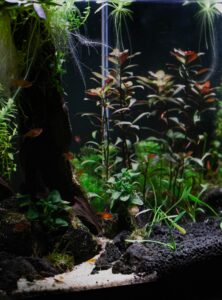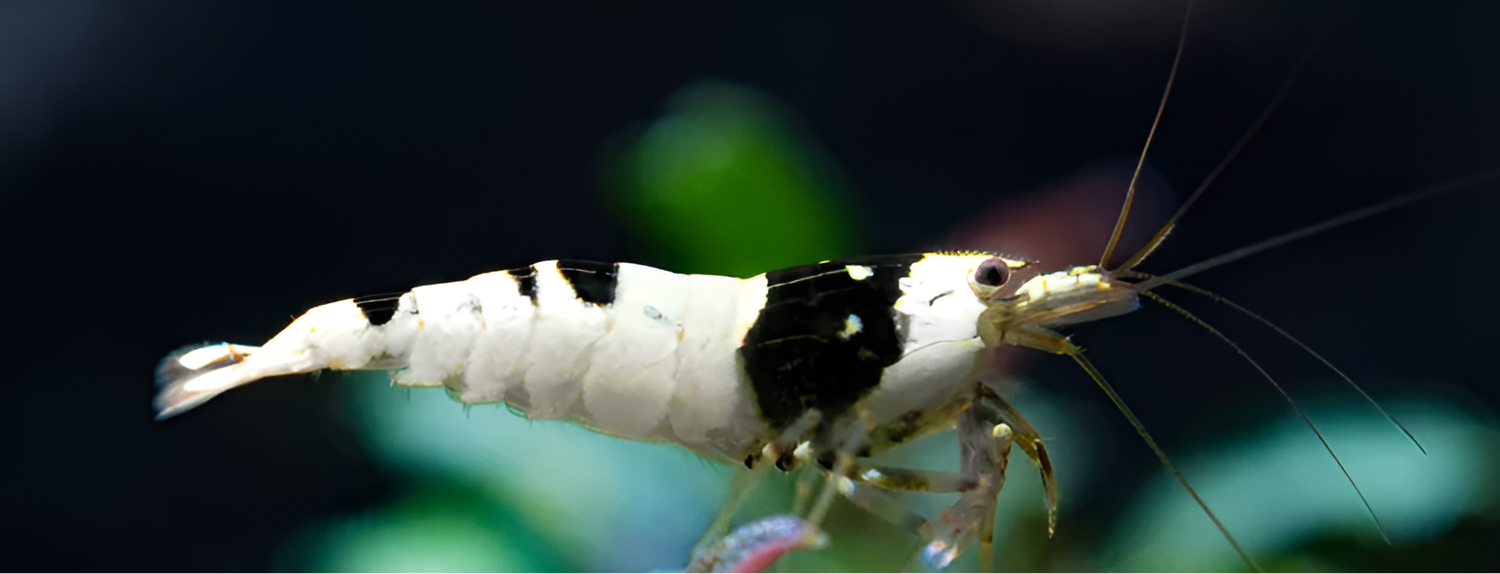Introduction to Crystal Black Shrimp
Crystal Black Shrimp (CBS), known scientifically as Caridina cantonensis, are a captivating freshwater shrimp species prized for their striking appearance and peaceful demeanor. Originating from the streams and rivers of southern China, these shrimp have become highly sought after in the aquarium hobby due to their unique coloration and manageable care requirements.Crystal Black Shrimp typically exhibit a translucent dark body with distinct black and white patterns, which can vary from opaque black to nearly transparent. They are relatively small, reaching an adult size of around 1.5 inches (3.8 cm). In optimal conditions, Crystal Black Shrimp can live up to 2 years, making them a durable choice for aquarists seeking an aesthetically pleasing and low-maintenance addition to their tanks.
History of Crystal Black Shrimp
The development of Crystal Black Shrimp traces back to selective breeding efforts aimed at enhancing the color and pattern traits of wild-caught Caridina cantonensis. These breeding programs have produced several color morphs, including the closely related Crystal Red Shrimp (CRS). Both CBS and CRS are descendants of the same ancestral species but differ significantly in coloration.Crystal Black Shrimp gained popularity alongside Crystal Red Shrimp in the early 2000s, quickly becoming a favorite among aquarists worldwide. Their adaptability to varying water conditions and peaceful nature in community tanks contributed to their rise in popularity within the aquarium hobby.
Crystal Black Shrimp Care and Ideal Water Parameters
Crystal Black Shrimp thrive in stable aquatic environments with specific water parameters closely resembling their natural habitat. Maintaining these conditions is crucial for their health and coloration:
- Total Dissolved Solids (TDS): 100-120 ppm (parts per million)
- pH: 5.4-6.2
- General Hardness (GH): 4-5 degrees
- Carbonate Hardness (KH): 0-1 degree
- Temperature: 60-72°F (15.5-22°C)
A well-established planted aquarium with ample hiding places and gentle water flow is ideal for Crystal Black Shrimp. Regular water changes and monitoring of water parameters are essential to ensure their long-term well-being and vibrant color display in captivity.
Setting Up a Successful CBS Tank
 To create an optimal environment for Crystal Black Shrimp (CBS), consider the following factors:
To create an optimal environment for Crystal Black Shrimp (CBS), consider the following factors:
- Tank size recommendations: A tank size of at least 5 gallons (19 liters) is recommended for a small group of CBS. Larger tanks, such as 10 gallons (38 liters) or more, provide more stable water parameters and room for a larger colony.
- Filtration options (focus on sponge filters): Sponge filters are preferred for CBS tanks because they provide gentle water flow and do not harm baby shrimp. They also support beneficial bacterial growth important for water quality.
- Substrate choices: Use substrates like fine gravel or specialized shrimp substrates that buffer pH and maintain stable water parameters suitable for CBS.
- Importance of hiding places and plants: Provide plenty of hiding places such as driftwood, rocks, and plants (like Java moss or Anubias). These decorations help reduce stress and provide surfaces for biofilm growth, a natural food source for CBS.
- Acclimation process: When introducing CBS to a new tank, drip acclimation is recommended to slowly adjust them to the tank’s water parameters and minimize stress.
Diet and Feeding
Crystal Black Shrimp are omnivorous scavengers in the wild. Their diet should include:
- Natural feeding habits: They graze on biofilm, algae, and decaying plant matter in their environment.
- Recommended commercial foods: High-quality shrimp pellets, flakes, and granules specifically formulated for shrimp. Ensure they are rich in plant matter and proteins.
- Supplemental foods (vegetables, leaves, etc.): Offer blanched vegetables like zucchini, spinach, and kale. Indian almond leaves or mulberry leaves provide additional nutrition and aid in molting.
- Feeding frequency and amount: Feed small amounts once or twice a day, only what they can consume within a few hours. Remove any uneaten food to maintain water quality.
Understanding CBS Grading
Crystal Black Shrimp are graded based on their color intensity, coverage, and pattern clarity. Basic principles include:
- Basic principles of CBS grading: Higher grades exhibit a more intense and uniform black coloration with minimal or no undesirable patterns. Grades range from A (highest) to C (lowest).
- Importance of grading in breeding and sales: Grading helps breeders selectively pair shrimp to improve color and pattern traits in future generations. Higher grades are more valuable in the aquarium trade.
- For a detailed explanation of CBS grading criteria and examples, visit our comprehensive CBS grading guide.
Color Grading
Crystal Black Shrimp (CBS) are graded based on their color intensity and coverage. The grading system typically includes:
- Description of different color grades: CBS are graded on a scale from C to SSS+ based on the intensity and uniformity of their black coloration. Grade SSS+ shrimp is the highest grade, exhibiting a completely solid, opaque black color with and white shell with no stray patterns. Grade C is the lowest grade, with shrimp having uneven black coloration, and transparency in their shells.
- Factors affecting color intensity: Factors such as genetics, diet, water quality, and environmental conditions can influence the color intensity of CBS. Selective breeding plays a crucial role in producing higher-grade specimens with desirable color traits.
- For a more detailed explanation of CBS color grading criteria and examples, refer to our comprehensive CBS grading guide.
Pattern Grading
Crystal Black Shrimp display various patterns, each with its own rarity and perceived value among enthusiasts. Common patterns include:
- Intro to types of patterns (e.g., no entry, hinomaru, mosura): Patterns like “no entry” feature a solid black coloration without any white markings. “Hinomaru” patterns showcase a circular red mark on the shrimp’s back. “Mosura” patterns exhibit a more intricate arrangement of black and white stripes or spots.
- Rarity and value of different patterns: Patterns like “hinomaru” and “mosura” are generally rarer and more sought after in the hobbyist market due to their distinctive and eye-catching appearances. Breeders often aim to enhance these patterns through selective breeding efforts.
- Explore our detailed CBS grading guide for a comprehensive overview of pattern variations and their grading criteria.
Breeding Crystal Black Shrimp
Breeding Crystal Black Shrimp can be rewarding but requires careful attention to their specific needs:
Understanding the various patterns and grading criteria of Caridina Mischlings can greatly improve your success in breeding and selecting high-quality specimens. For those starting out, consulting resources like ‘Mischlings 101: Demystifying Caridina Mischlings – A Breeder’s Roadmap‘ can provide valuable insights into pattern recognition and breeding strategies.
- Breeding setup requirements: Provide a stable and well-established aquarium with ample hiding places and plants. Maintain optimal water parameters and ensure a balanced diet to promote breeding behavior.
- Mating behavior: CBS typically engage in courtship displays, where males will chase females and perform a mating dance involving antennae tapping. Females carry eggs underneath their tails until they hatch.
- Egg development and hatching: After mating, females will carry fertilized eggs for about 3-4 weeks. During this time, provide optimal water conditions and ensure a steady food supply to support the developing eggs.
- Care for shrimplets: Once hatched, shrimplets resemble miniature versions of adults and will feed on biofilm and powdered foods. Maintain stable water parameters and offer suitable hiding places to protect shrimplets from predators and ensure their growth.
Common Health Issues and Treatments
Crystal Black Shrimp (CBS) are generally hardy, but like all aquarium inhabitants, they can experience health issues. Here are some common concerns:
- Signs of stress or illness: Symptoms include lethargy, decreased appetite, abnormal behavior (like swimming erratically), discolored or opaque shell, and unusual markings or growths.
- Common diseases and parasites: CBS may be susceptible to diseases like bacterial infections (such as bacterial shell disease), fungal infections, and parasitic infestations like planaria or hydra.
- Prevention and treatment options: Maintain stable water parameters, perform regular water changes, and avoid overfeeding to prevent stress and disease. Quarantine new additions to prevent introducing diseases. Treatments include, antibiotics (for bacterial infections), and specialized treatments for parasites as recommended.
Compatible Tank Mates
When selecting tank mates for Crystal Black Shrimp, consider their peaceful nature and specific requirements:
- Suitable shrimp species: Other dwarf shrimp species like other Caridina or Neocaridina species can coexist peacefully, provided their water parameters are compatible.
- Compatible fish species: Small, non-aggressive fish such as small rasboras, tetras, or some catfish species can be suitable. Avoid fish known to prey on shrimp, like larger cichlids or aggressive species. No fish are not recommended in a breeding colony.
FAQs
Addressing common questions about Crystal Black Shrimp:
- Can CBS be kept with Crystal Red Shrimp? Yes, CBS and Crystal Red Shrimp (CRS) are closely related and can be kept together, but avoid crossbreeding if you want to maintain pure strains.
- Can CBS be kept with fish? Yes, as long as the fish are peaceful and do not pose a threat to the shrimp. Always monitor their interactions to ensure the shrimp are not stressed or harassed. No fish are not recommended in a breeding colony.
- How long do CBS live? Crystal Black Shrimp typically live for about 1.5 to 2 years, depending on the quality of care provided.
- How often do CBS molt? CBS molt periodically as they grow, shedding their exoskeleton to accommodate their increasing size. Molting frequency varies but is more frequent in younger shrimp.
- What causes CBS to lose color? Stress, poor water quality, inadequate diet, and illness can cause CBS to lose color. Ensuring optimal conditions and diet will help maintain their vibrant coloration.
Buying Guide
When purchasing Crystal Black Shrimp (CBS), it’s important to ensure you are selecting healthy specimens and sourcing them from reputable suppliers:
- How to spot healthy shrimp: Look for active shrimp that are moving around the tank, have clear and vibrant coloration (for CBS, solid black with minimal to no transparency), and appear alert and responsive to their surroundings. Identify reputable lineages. When creating a breeding colony, it’s crucial to begin with purebred or near purebred lineages to ensure consistent offspring and predictable gene inheritance, without the influence of other variant genes.
- Selecting the best specimens: Choose shrimp with consistent coloration and patterns according to your preference (e.g., solid black for higher grades). Avoid shrimp with damaged appendages or signs of illness.
- Reputable sources for purchasing CBS: Purchase from established breeders or reputable online and local aquarium stores known for quality shrimp. Seek recommendations from fellow hobbyists or forums with positive reviews.
- Shipping considerations: Ensure the seller uses appropriate packaging and shipping methods to minimize stress during transit. Consider weather conditions and choose expedited shipping options if necessary to maintain water temperature and quality.
Advanced CBS Keeping
For experienced hobbyists interested in advancing their Crystal Black Shrimp keeping skills, consider the following:
- Selective breeding techniques: Selectively breed CBS to enhance desirable traits such as color intensity, pattern clarity, and size. Maintain detailed records of breeding pairs and offspring to track genetic progress.
- Creating unique color morphs: Experiment with breeding programs to develop unique color variations within the CBS species. This can involve careful selection of breeding pairs based on desired color traits.
- Participating in shrimp competitions: Showcase your best CBS specimens in shrimp competitions where judges evaluate based on color, pattern, and overall quality. Participating in competitions can provide feedback and recognition within the shrimp keeping community.










